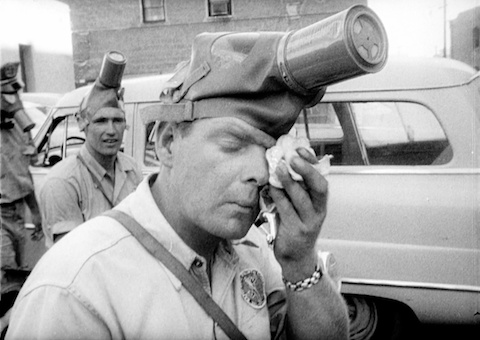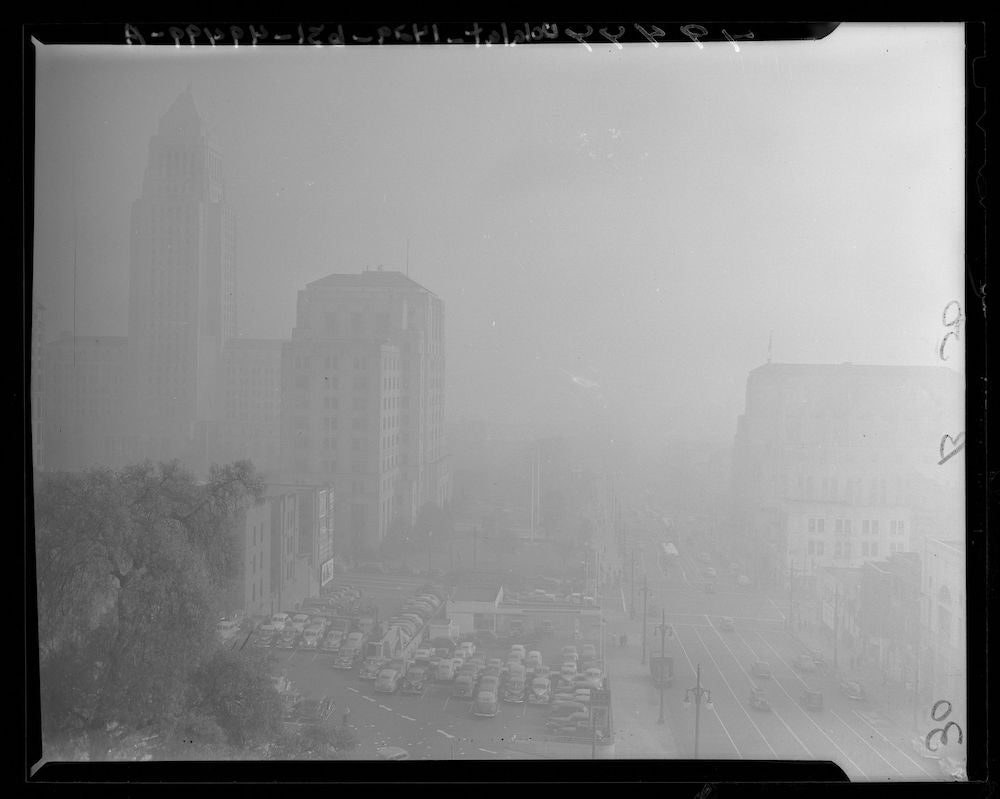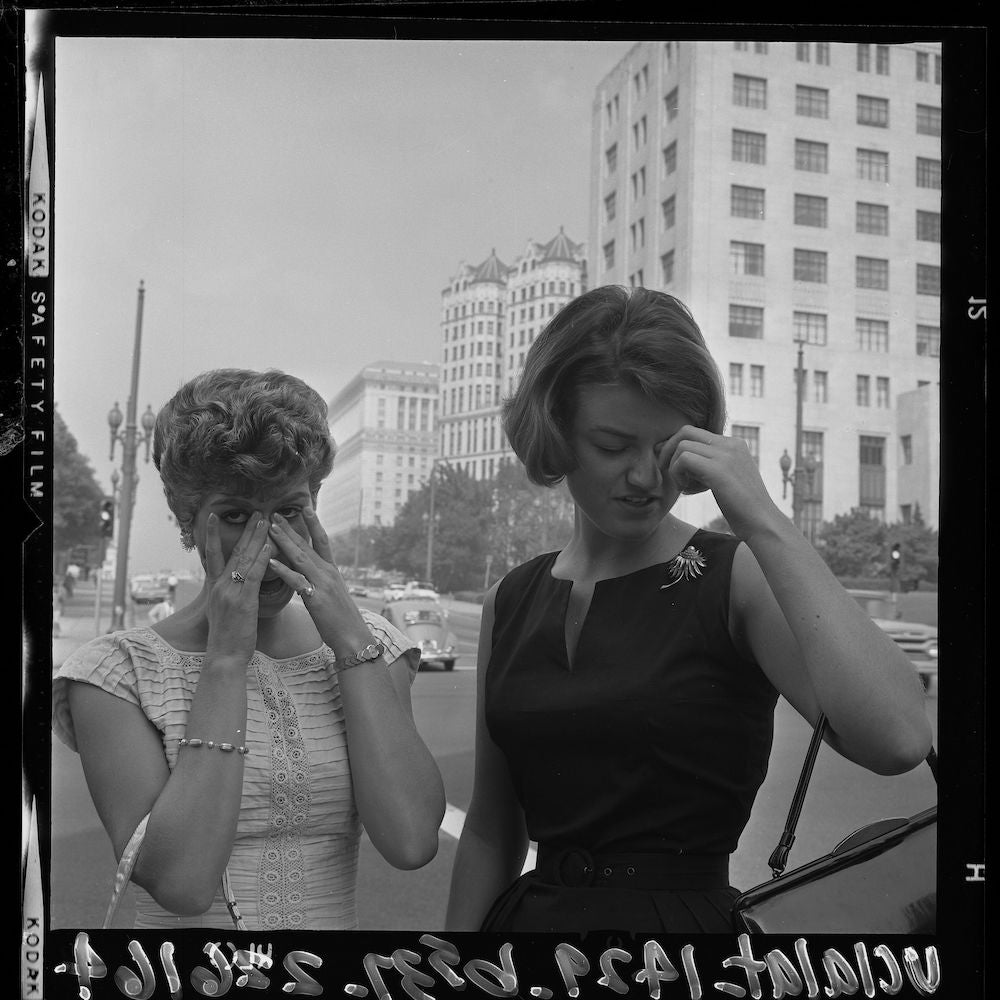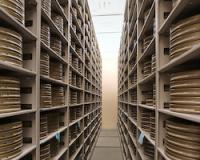
Hearst Metrotone News
70 years ago, in the high heat of mid-September 1955, Los Angeles was besieged by air pollution as it endured the densest smog on record. Newspapers wrote of a “smog war” and “smog attack” that threatened to disrupt the flow of daily life in the city. Angelenos wiped away smog-induced tears. Motorcyclists wore gas masks. State and local leaders pointed fingers and called for action, restricting the use of backyard trash incinerators, urging for carpools and improved public transportation, and investigating nearby oil refineries. As Angelenos were confronted by the severe impact of air pollution, leaders and ordinary residents considered the consequences of both industrialization and individual actions on the environment. A selection of letters to the Los Angeles Times, below, paints a picture of how some Angelenos experienced and responded to the smog, while underscoring the decades-long challenge of curbing pollution.
Watch newsreel: “Los Angeles seeks remedy as record smog covers city” (released Sept. 16, 1955)
“Shrouded by the worst blanket of smog in its history, the California city studies methods to avert a disaster. A careful record of ozone density is kept as the danger mounts.”
From the Hearst Metrotone News Collection at the UCLA Film & Television Archive. Access thousands of newsreels online courtesy of the Archive and The Packard Humanities Institute at newsreels.net.

A vast online repository of historical newspapers is available to UCLA students, faculty and staff through UCLA Library. From the Los Angeles Times archive:
Letter to the Times: “Smog Exodus” (Los Angeles Times, Sept. 16, 1955)
“We live in a practically smog-free vicinity but have to work in Hollywood. It is like being condemned to death — and probably is — from lung cancer in a few more years — to come down into the poison air of Los Angeles […] I believe the only solution and the only chance for life for a few more years — if it is not already too late from breathing the germ-infested air — is for a general exodus from this city of slow death. There is really no excuse for any city, and especially one of this magnitude, to be allowed to get into a condition of this kind.”—Mrs. C.L.I., Encino
Letter to the Times: “Smog Courage” (Los Angeles Times, Sept. 18, 1955)
“After years of bungling and spending millions of the public’s dollars, we are no nearer a solution than before. They try to lay it on the back-yard incinerators and the exhausts from automobiles and say little or nothing about the big manufacturing plants. We never had smog until the big manufacturing plants began to come in by the dozens and the smaller ones by the hundreds […] When this problem is taken out of politics and we put men on the job who are not afraid to go after the real offenders, we can lick the smog.”—L.C. Lee, Los Angeles
Letter to the Times: “Smog Apathy” (Los Angeles Times, Sept. 22, 1955)
“I am amazed at the general apathy among city officials; also among the army of appointees who are investigating smog control. Los Angeles, proper, happens to be situated in a valley. Nothing can be done about this. The weather has been inordinately hot for 30 days, more or less. Nothing can be done about this either. The factory and smelting menace could have been removed long ago. The city can condemn both of them. It’s a disgrace that this was not done long ago. Private incinerators should be condemned at once [...] Public and private cars are constantly causing more smog. The transportation menace is serious. But, compared with other causes, this is negligible.”—Walter E. Bidwell, Hollywood
Letter to the Times: “Trees and Smog” (Los Angeles Times, Sept. 23, 1955)
“When I first came here, Los Angeles had many treelined streets, restful to the eyes, and refreshing to the atmosphere. We didn’t have many automobiles, but neither was the city so far flung. As the city developed, the cry was, ‘the trees must go,’ and we chopped them down. And the city spread out, and more and more cars came, until it is rated the highest per capita in the nation. True, we need the cars, but we have no foliage trees in our streets to absorb the poisonous gases from these cars, and I am wondering aren’t our eyes smarting because of our earlier folly in destroying our trees?”—Thekla M. Widney, Los Angeles
Letter to the Times: “Smog Tears” (Los Angeles Times, Sept. 27, 1955)
“Another bit of maddening scientific dalliance! Tears caused by smog differ from those caused by pain, anger, or sorrow. But how can science separate these tears, for tears of rage, pain, and frustration will mingle in the eyes of every suffering citizen who has been made a monkey of and is now invited to serve as a human guinea pig.”—Ethel A. Stanbach, Puente
Explore historical smog-related photos from the UCLA Library Digital Collections, including the Los Angeles Times Photographic Collection.

“Smoggy day in Los Angeles, Calif., 1960.” March 23, 1960. Publisher: Los Angeles Times. UCLA Library Special Collections.

“Two women on smoggy day in downtown Los Angeles, Calif., 1964.” October 7, 1964. Publisher: Los Angeles Times. UCLA Library Special Collections.
—Digital Communications Assistant Gillian Gee and Digital Content Manager Jennifer Rhee






 Mobile Navigation
Mobile Navigation

